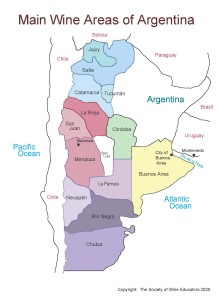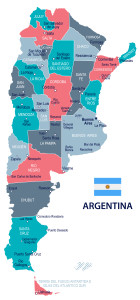The wine industry of Argentina has expanded its scope in recent years, and new vineyards are moving into areas of the country well beyond the established viticultural zones near the Andes Mountains. Portions of the province of Buenos Aires—boasting some vineyards within just a few miles of the Atlantic Ocean—are now considered prime wine-producing regions. Other provinces to watch are Chubut (where new vineyards reach further south in Argentina than ever before) and Córdoba (located east of the Andes). Read on for a bit more information on these new regions to watch!
Chubut: Chubut, located to the south of Río Negro, is currently the southernmost wine-producing province in Argentina. It also boasts one of the southernmost vineyards in the world—Sarmiento—which sits below the 45th parallel (South). Many of the vineyards of Chubut are planted in the steppes (relatively flat, grassland areas) close to the Atlantic Coast. Nearly 60% of Chubut’s 180 acres (73 ha) of vines are planted to red varieties. Pinot Noir is the leading grape, followed by Chardonnay, Merlot, Malbec, and Torrontés Riojano. Producers in Chubut include Bodega Otronia, Viñedo Familia Adamow, and Casa Yagüe.
Córdoba: The Argentina province of Córdoba is located almost in the geographic center of the country. The region—located east of the Andes—contains a series of moderate-elevation mountain ranges in its western portion and an extensive plain covering much of the east. Jesuit missionaries hailing from Spain settled in Córdoba in the early 1600s and established several estancias (working ranches) complete with schools, churches, orchards, and vineyards. The Jesuits produced wine until 1767, when the Spanish crown expelled them from Argentina. At this point most of the vineyards of Córdoba were abandoned, and wine production stagnated in the area until the 1870s when a strong wave of Italian immigration brought the industry back to life. Beginning in the 1990s, the area is experiencing a renewed focus on export wines, and vineyard holdings in Córdoba are once again expanding. New vineyards are planted mainly to Merlot, Pinot Noir, Malbec, Chardonnay, and Sauvignon Blanc. Producers in Córdoba include Bodega Terra Camiare, Famiglia Furfaro, and Bodega la Caroyense.
Buenos Aires: In recent years, as Argentine wine producers have begun to extend the limits of the country’s viticulture to the east, the province of Buenos Aires has joined the ranks of emerging wine regions. The province currently contains less than 400 acres (160 ha) of vines in total, with Sauvignon Blanc and Chardonnay as the leading grape varieties. A small-but-diverse selection of red grapes, including Pinot Noir, are grown as well. In the southeast of the province, the Chapadmalal GI—located near the town of Mar del Plata and about 200 miles (320 km) south of the city of Buenos Aires—currently contains the easternmost vineyards in the country, some of which are planted just a few miles from the Atlantic Ocean. This ocean-influenced region is much cooler and receives more rainfall than many of Argentina’s other vineyard areas. Leading producers in this area include Bodega y Viñedos Al Este and Wapisa Wines – Patagonia Atlántica.
Nora Favelukes, of QW US Wine Market Experts presented a session that showcased an excellent slate of wine from these and other emerging wine regions of Argentina at SWE’s 43rd Annual Conference in August of 2019. You can read more about Nora’s session here.
References/for more information:
- https://www.winesofargentina.org/en
- http://www.vinodelsol.com/thewineries/wapisa.html
- https://www.otronia.com/
- http://www.casayague.com/
- https://cordobawinetravel.com.ar/historia/
- http://famigliafurfaro.com/site/
Post authored by Jane A. Nickles…your blog administrator: jnickles@societyofwineeducators.org


